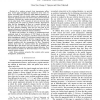Free Online Productivity Tools
i2Speak
i2Symbol
i2OCR
iTex2Img
iWeb2Print
iWeb2Shot
i2Type
iPdf2Split
iPdf2Merge
i2Bopomofo
i2Arabic
i2Style
i2Image
i2PDF
iLatex2Rtf
Sci2ools
112
click to vote
ICC
2007
IEEE
2007
IEEE
CA-AQM: Channel-Aware Active Queue Management for Wireless Networks
—In a wireless network, data transmission suffers from varied signal strengths and channel bit error rates. To ensure successful packet reception under different channel conditions, automatic bit rate control schemes are implemented to adjust the transmission bit rates based on the perceived channel conditions. This leads to a wireless network with diverse bit rates. On the other hand, TCP is unaware of such rate diversity when it performs flow rate control in wireless networks. Experiments show that the throughput of flows in a wireless network are driven by the one with the lowest bit rate, (i.e., the one with the worst channel condition). This does not only lead to low channel utilization, but also fluctuated performance for all flows independent of their individual channel conditions. To address this problem, we conduct an optimization-based analytical study of such behavior of TCP. Based on this optimization framework, we present a joint flow control and active queue manage...
Related Content
| Added | 03 Jun 2010 |
| Updated | 03 Jun 2010 |
| Type | Conference |
| Year | 2007 |
| Where | ICC |
| Authors | Yuan Xue, Hoang Nguyen, Klara Nahrstedt |
Comments (0)

